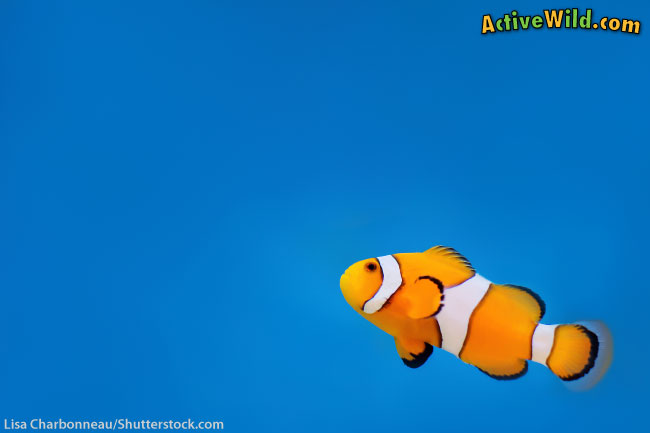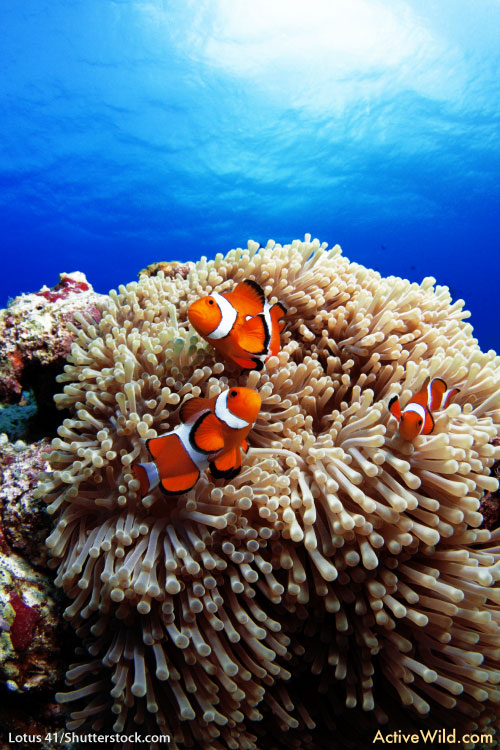This page contains amazing ocellaris clownfish facts for kids (and adults). This animal is part of the Active Wild Online Zoo: information, pictures and videos of all your favorite animals!
Ocellaris Clownfish Quick Facts
- Other Name(s): False percula clownfish, common clownfish, anemonefish
- Scientific name: Amphiprion ocellaris
- Type of Animal: Fish
- Animal Family: Pomacentridae. The ocellaris clownfish belongs to the subfamily Amphiprioninae. Members of this family are also known as Clownfish or anemonefish.
- Where Found: Warmer waters of the Indian and Pacific Oceans, Japan and Southeast Asia, Australia
- Length: Up to 110 mm (4.3 in.), average length: 80 mm (3.15 in.)
- Weight: 250 grams
- Conservation Status: Least Concern
- Other interesting Ocellaris Clownfish facts: All Ocellaris Clownfish start life as males, and some later turn into females!
Ocellaris Clownfish Video
You can see ocellaris clownfish in the wild in the video below:
Meet the Ocellaris Clownfish: Introduction
Due to a starring role in the Disney movie Finding Nemo, the Ocellaris Clownfish is one of the world’s best-known fishes.
Its bright orange color and three white stripes make it instantly recognizable. However, there is more to this fascinating fish than its good looks.
The Ocellaris Clownfish leads an incredible life that involves living in partnership with dangerous stinging sea anemones … and changing from male to female!
Let’s learn more about the movie star of the coral reef!
How to Recognize an Ocellaris Clownfish
The Ocellaris clownfish is a small, brightly-colored fish with prominent fins. It is best known in its orange form, but its color varies depending on where it lives. In some areas (particularly near Australia) it is almost black.
The Ocellaris clownfish has three vertical white bands running around its body. At the edge of each stripe is a thin line of black. The fins also have a thin black outline.
The bright colors and white stripes resemble a clown’s makeup, which is how the clownfish got its name.
Where Does The Ocellaris Clownfish Live?
The Ocellaris clownfish lives on coral reefs and in shallow lagoons. It is found in warm water areas of the Indian and Pacific Oceans, and is present near Japan, Southeast Asia and Australia.
Ocellaris Clownfish and Sea Anemones: A Symbiotic Relationship
The Ocellaris clownfish has what is known as a ‘symbiotic relationship’ with sea anemones.
A symbiotic relationship is when two different species have a close relationship which is mutually beneficial.
Sea anemones are animals that are attached to underwater objects. They trap their prey (which includes fish and crustaceans) in their stinging tentacles.
The slimy coat of the Ocellaris clownfish protects it from the anemone’s stings, allowing it to live among the tentacles without harm. The clown fish is not a strong swimmer, and the anemone provides shelter and protection from predators.
In turn, the Ocellaris clownfish eats parasites that are harmful to the anemone, helps water to circulate around the anemone’s body, and its waste matter may also provide the anemone with nutrients. This all leads to a healthier, cleaner anemone. In addition, the Ocellaris clownfish makes a high-pitched sound that deters butterfly fish from eating the sea anemone.
As soon as it is able, a young Ocellaris clownfish attempts to find a suitable anemone in which to live. It takes a while for the Ocellaris clownfish to build up immunity to the anemone’s sting, which it does by rubbing its belly and fins on the ends of the tentacles.
The three sea anemone species that the Ocellaris clownfish lives with are: Heteractis magnifica, Stichodactyla gigantea, and Stichodactyla mertensii. The Ocellaris clownfish can identify these species by smell, and is imprinted with this knowledge while in the nest.
Ocellaris clownfish Lifestyle: Changing From Males into Females!
Incredibly, all Ocellaris clownfish begin life as males, and some later change into females!
Several clownfish live in a group in a single anemone. Juvenile fish join a group at the bottom of the social ladder. It can be hard for a juvenile fish to find a suitable home, as clownfish are territorial and aggressive to outsiders.
The dominant fish in a group is a female, the next-largest is an adult male, and the others are juveniles. If the female dies, the adult male changes into a female, and becomes the dominant member of the group. The largest juvenile then matures to become the adult male of the group.
Ocellaris clownfish Breeding
Ocellaris clownfish breeding usually takes place when there is a full moon. The male clears a hole underneath the anemone, and acts aggressively by chasing and biting the female.
The female lays between 100 and 1,000 eggs on the nest, which the male then fertilizes. The eggs take around a week to hatch. The newly-hatched larvae (small, undeveloped fish) live on plankton for between 1 and 2 weeks, during which time they continue to develop into juvenile fish. The young fish then attempt to find a suitable anemone in which to live.
Is The Ocellaris clownfish Endangered?
The Ocellaris clownfish is not endangered, and is rated ‘Least Concern’ in the IUCN Red List.
Ocellaris Clownfish Facts For Kids: Questions
Q1. What is the conservation status of the Ocellaris clownfish?
- a) Critically endangered
- b) Vulnerable
- c) Least Concern
Q2. What is the beneficial relationship between sea anemones and Ocellaris Clownfish called?
- a) Symbiotic relationship
- b) Amniotic relationship
- c) Parasitic relationship
Q3. What is the Ocellaris clownfish’s preferred habitat?
- a) Arctic coasts.
- b) Coral reefs
- c) Freshwater estuaries
Now see more of the amazing animals in the Active Wild Online Zoo!
Visit a world-class zoo ... without leaving your home! At the Active Wild Online Zoo you'll find FREE pictures, facts and information on the world's most incredible animals. Each page also features a specially chosen video, and a list of questions to test your knowledge!
- See other animals in the online zoo now!
- Become a fish expert: Fish - The Ultimate Guide
- Discover more about fish: Types of Fish with Pictures & Facts
- Know someone who loves fish? Get some gift ideas: Fish Gift Ideas
Ocellaris Clownfish Facts For Kids: Answers
Q1) c, Q2) a, Q3) b





